Friday 28 March 2014
Eurasian Harvest Mouse - Miniature Master of Camouflage
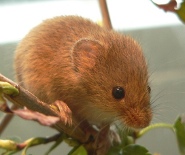
The
Eurasian harvest mouse (Micromys minutus) is nature's miniature master of camouflage. Though tiny, it's a slow-moving mouse, and it has many predators, among them
owls, foxes, cats, and weasels. When the mouse feels under threat, it adopts a defensive posture by remaining motionless, effectively camouflaging itself against the backdrop of its surroundings.
The Eurasian harvest mouse is widely distributed over Europe and Asia. Since this little mouse is remarkably adaptable and can be found in Great Britain, throughout Russia, and all the way to Japan, it isn't considered endangered. Micromys minutus thrives in many types of habitats, from grasslands and wetlands to bamboo stands. If human development encroaches on its natural habitat, this little mouse can make its home in people's gardens or even in drainage ditches.
An adult Eurasian harvest mouse weighs from 5-9 grams (.176-.316 ounce) and reaches a length anywhere from 50-70 mm (2-2.75 inches). Its body is covered in thick, soft fur, which is buff or reddish-brown in color. The mouse has a naked tail, roughly the same length as its body. The tail is semi-prehensile and allows the mouse to easily climb grass stalks and find seeds to eat.
The Eurasian harvest mouse's diet, like its range and habitat, is varied. Its primary fare is grass, seeds, and berries, but in summertime, it eats insects and larvae and sometimes feeds on fungi and moss. It likes to feed in cornfields as well, but farmers don't worry too much about its impact. The mouse doesn't eat enough vegetation to cause major problems, and it actually helps out farmers by eating insects that damage crops.
A round-the-clock rodent, the Eurasian harvest mouse is active throughout the day and night on three-hour cycles. It spends half an hour eating, then it sleeps for the remainder of its cycle. In winter, Eurasian harvest mice don't hibernate. They either build nests out of shredded grass or they congregate in barns or grain silos.
The female Eurasian harvest mouse gives birth to her litter in grass nests constructed approximately 100 cm (39 inches) aboveground. Baby mice that are only three days old can already hang onto grass stalks. The lifespan of Micromys minutus in the wild is short. They're lucky to make it to eighteen months old, and many only make it to six months. In captivity, however, these tiny mice have lived to be five years old.
Picture of the Eurasian harvest mouse by Hendrik Osadnik, licensed under
GNU Free Documentation License and
Creative Commons Attribution-Share Alike 3.0 Unported license.
You can help spreading the word about this animal by liking it on facebook
Permanent Link
Friday 21 March 2014
Pygmy Slow Loris - Toxic but Cute
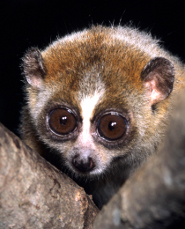
The Pygmy slow loris (
Nycticebus pygmaeus) is a rare, large-eyed nocturnal primate. Although, they primarily live in the tropical forests of
Vietnam,
Laos,
Cambodia and
China, they can also been found in Vietnam's bamboo thickets and Laos's evergreen forests. The Pygmy slow loris almost became extinct in Vietnam after much of its habitat was destroyed by war. Today, deforestation is still a major threat to this species, and it is currently listed as vulnerable on the International Union for Conservation of Nature's Red List.
The Pygmy slow loris is a very small
primate, growing to only approximately 15 to 25 centimeters (roughly 6 to 10 inches) in length. It typically weighs on average 400 grams or 14 ounces. The loris has a stubby tail, light brown to deep reddish brown fur, white markings on its face, as well as a gray or white underside. This primate also has large, forward facing eyes that help it to see at night.
Lorises are nocturnal omnivores. They enjoy dining on a wide selection of food, including floral nectar, tree gum or sap, plants, fruits, small mammals and insects. These creatures have strong hands and feet that allow them to grip branches very tightly. When a loris spots prey, it will grip a branch tightly with its hind legs and then lunge forward to grab it. It will also use the element of surprise, allowing unsuspecting prey to approach it before launching an attack. The Pygmy slow loris can rarely be found on the ground, preferring the comfort and safety of the trees. Predators of the Pygmy slow loris include pythons, orangutans and hawk eagles.
The Pygmy slow loris is a mostly solitary creature. They typically only come together during their mating season, although they have occasionally been found sleeping together in small groups. When asleep, the loris will curl up in a tight ball, while still clinging to a branch.
Though lorises are cute, resembling tiny teddy bears, they are one of the few mammals capable of producing a toxin. When frightened, these small primates have been known to lick the area under their arms where the toxin is produced, so that if it bites something, the poison will get into the wound. Though the toxin is not known to be fatal to humans, it may cause painful swelling. In addition, one woman who was bitten was reported to have gone into anaphylactic shock.
Picture of the pygmy slow loris by David Haring / Duke Lemur Center, licensed under
Creative Commons Attribution-Share Alike 3.0 Unported license.
You can help spreading the word about this animal by liking it on facebook
Permanent Link
Tuesday 18 March 2014
Mexican hairy dwarf porcupine
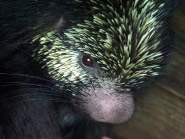
The
Mexican Hairy Dwarf Porcupine or Tree Porcupine (
Sphiggurus mexicanus) is a rodent that is found in many Latin American countries and surrounding areas, such as (as its name indicates) Mexico, Guatemala, Honduras, Costa Rica, Panama, and possibly two other locations. It is not classed as endangered, and is in fact classed 'least concern' due to its abundance and population. Adult Mexican Hairy Dwarf Porcupines range in size from 20 to 32 inches (that's roughly 54.61 cm to 81.28 cm) in lengths with a long tail that is from anywhere around one third to two fifths of its total body length. They usually weight about 3.2 to 5.5 lbs (1.4 to 2.48 kg) and have dark fur, usually brown to black in color that covers most of their spines which in turn are present across the porcupine’s back. The head is usually marked by yellow or pale color spines that are visible through the fur itself, and also by light pale colored fur fuzz around the ears. The long tail has almost no fur and is prehensile (meaning it can be used rather than just for balance) and resembles a large rat tail.
The porcupine of this species prefers to remain nocturnal, they find safety in being arboreal (living above the ground) while others have been (rarely) seen making dens and living in darker secluded areas below ground and out of the way. They are very territorial and males will not tolerate other males near them – however they will allow females to remain close. During the night they hunt down good sources of fruits, seeds, and edible leaves along with buds. They are likely to prefer the fruit and seed varieties over leaves and buds, however when there is none of their preferred foods, they will eat the latter. Unfortunately for the Mexican Hairy Dwarf Porcupine, they are used as a food-source for humans; however the collection and gathering must be done carefully.
The Mexican Hairy Dwarf Porcupine's scientific classification name is Sphiggurus Mexicanus, which means its species is Mexicanus and its genus is Sphiggurus. Within the genus Sphiggurus there are eight other species of porcupine, and all live in the western hemisphere. They belong to the subfamily Erethizontinae, which in turn belongs to the family Erthizontidae, which has five Genera. These are different than the Old World porcupine (Eastern Hemisphere), and thus are called New World (Western Hemisphere) porcupine. In turn this family belongs to the parvorder Caviomorpha, which contains many other families (twelve living, three known extinct) and contain such animals as Chinchillas, Capybaras, and many more. Caviomorpha belongs to the infraorder Hystricognathi, which belongs to the suborder Hystricomorpha. Hystricomorpha is a huge selection of rodents; however it belongs to the order Rodentia, which contains all rodents – which makes up roughly 40% of all mammalian species – with 2,277 knowing living examples.
Their weapon, the quill, is a primarily defensive one, in which the specialized hairs are extremely sharp and detach easily. The quill, once embedded in flesh, will continue to go inward, as each quill has microscopic fibers that are pointed away from the tip toward the other end. The quills themselves can reach up to three inches in length, and make for a painful removal due to their microscopically barbed nature. A common misconception is that a porcupine can 'fire' a quill at you – this is not true as contact must be made for the quill to stick, and there is no mechanism for flinging a quill except for a minor shaking for grooming reasons.
Interesting Fact
Porcupines love salt, in fact many have been found causing chaos by chewing on wires under a car which have been coated with road salt, getting into cabinets for salty chips, and even eating plywood that has been treated with sodium nitrates. Often times areas with porcupine populations will place salt licks out of the way so that they do not get in trouble.
Picture of the Mexican hairy dwarf porcupine by Patrick Gijsbers, licensed under
GFPL
You can help spreading the word about this animal by liking it on facebook
Permanent Link
Friday 14 March 2014
Northern Saw-Whet Owl - Cute Trickster
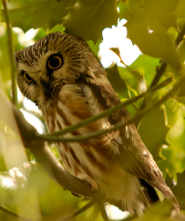
The Northern Saw-Whet Owl (
Aegolius Acadicus), is a member of the Strigidae classification of owls from the 26 genera known as typical owls. This distinction is divided down to four Aegolius species commonly called 'small forest owls'. The Northern Saw-Whet is one of the smallest owls. They have a short, stocky build with a relatively short tail. The average Saw-Whet measures 7 - 8.5 or 18 - 22cm in length. Their weight ranges from 2.6 - 4.6 ounces or 75 - 130 grams. Wingspan of these forest owls are 17-21 inches or 23-53 cm.
Acadicus indicates where the owls were originally sighted. European explorers came across them in a North America location called Acadia which is now Nova Scotia. The name Saw-Whet was coined because of the unique sound these owls emit. They are an attractive bird with fluffy plumage of brownish red streaked with white and spotted underneath. Their flight feathers are spotted with white. The owls have a rather large head and unlike other owls, no ear tufts.
Northern Saw-Whet owls live and nest in dense forest areas. They prefer coniferous trees but will roost in heavy shrubs. They often build their nests in places where woodpeckers, like the Pileated and
Northern Flicker, have hollowed out a hole. They prefer to nest alongside creeks and streams. Saw-Whet owls are carnivorous, existing mostly on small mammals, frogs and insects. They also kill and eat birds like sparrows, chickadees or even larger cardinals and doves. The Saw-Whet has a curious habit of 'freezing' their left-overs. Rarely do they eat an entire carcass but tear it in half and store the remaining meal inside the nest.
In breeding the male picks out the nest and lures the female with song, dance and a mouse in its bill. They breed from March through July, typical nest is five to six eggs. The male provides food during the broody season, about 21 days, but the female keeps the nest tidy. When the nestling are about 18 days old she finds a new home but helps feed the young owls for several weeks.
Northern Saw-Whet owls are not on an endangered list. Their predators are larger owls,
Cooper's Hawks and similar raptors. Life expectancy is from five to eight years.
The Northern Saw-Whet owls are also tricksters. If found by humans they sit very still trying to impress them with their tameness and cuteness, when in fact they can be quite vicious.
Picture of the Northern Saw-Whet Owl by
brendan.lally, licensed under the
Creative Commons Attribution 2.0 Generic license.
You can help spreading the word about this animal by liking it on facebook
Permanent Link
Tuesday 11 March 2014
The Charming and Social Degu
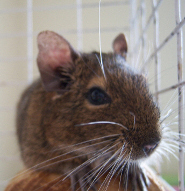
The degu (
Octodon degus) is a small mammal belonging to the rodent family, and is most closely related to the guinea pig and chinchilla. Degus are sometimes referred to as brush-tailed rats, and originate from the grasslands of
Chile. They average at about 25 to 30 centimeters (9.8–12.2 inches) in length and weigh 170 to 300 grams (6-11 ounces). The degu has small ears, powerful hind legs and a long tail similar to a rat's tail except furry. The degu's genus name, Octodon, comes from the appearance of its front teeth, which are in the shape of a figure 8.
Degus are strict herbivores, and in the wild their diet consists largely of dried grasses, shrubs and the occasional seed. One interesting fact about the degu's diet is that these animals seem to be highly susceptible to diabetes due to their natural diet consisting of very low amounts of sugar. For this reason, degus have become popular in the medical research field.
Degus are highly social creatures, and in the wild they live together as large families in burrows. They are communal diggers, and organize coordinated digging projects. Through teamwork, degus create vast circuits of tunnels and nests that couldn't be made by one individual degu. Even the female degus will sometimes nest and nurse their pups communally. Degus tend to forage for food in groups as well, in order to increase the chance of detecting nearby predators. They communicate primarily by sound, and can produce up to 15 unique sounds. Degus are diurnal, meaning they sleep during the peak daylight and nighttime hours and awaken during dusk and dawn, when it is harder for predators to find them as they forage for food.
Because of their popularity in diabetes research, degus were imported from Chile during the 1950s, and it was found that they make charming pets. While not mainstream pets yet, they are slowly becoming more popular. Degus are quite easily tamed, and remain active, playful and extremely social in captivity. They are very inquisitive and like to chew, however, so a large metal cage with plenty of running and climbing room is a must. Also, degu owners must make sure to provide their pets with other degu companions, since they are such social animals. They must also make sure to provide the right type of low-sugar diet. Degus will even bathe themselves in dust like chinchillas do.
Picture of the degu by Jessica Skinner (
Daintiest at en.wikipedia), licensed under
Creative Commons Attribution 3.0 Unported license.
You can help spreading the word about this animal by liking it on facebook
Permanent Link
Friday 07 March 2014
The Japanese Sawshark -- the Samurai of the Ocean
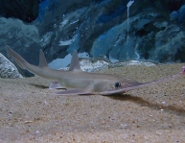
The
Japanese sawshark (
Pristiophorus japonicus) is one of the ocean's more bizarre-looking creatures. It has a flat snout, studded with teeth, which resembles a serrated saw. Protruding from the middle of the saw-like snout are two long, sensitive, whisker-like barbels. The sawshark uses these barbels, along with electro-receptors located on the underside of its saw -- which are known as ampullae of Lorenzini -- to help it find prey buried in the sand as it cruises along the bottom of the ocean. The Japanese sawfish typically feeds on fish, squid, shrimp and other crustaceans. Once it locates its prey, the Japanese sawfish will first use its snout to uncover its prey from the sand and then kill or maim it with savage slashes of its saw-like snout.
The Japanese sawshark is not a big shark and typically does not grow larger than one-and-half meters or six feet in length. It is sometimes mistaken for a similar looking creature known as the sawfish, which actually belongs to the ray family. Sawfish do not have barbels and the teeth located on its snout are all evenly sized, whereas the teeth of a sawshark alternate from big to little to big. In addition, the sawshark has gills on the side of its head, while the gills of a sawfish are located on its underside.
The Japanese sawshark is ovoviviparous, which means that its babies, known as pups, develop in eggs while inside the mother's body. The gestation period for a sawshark is typically 12 months and an average litter size is ten pups. It is believed that a Japanese sawshark can live up to 15 years in the wild.
This shark's main predator are humans, and its flesh is especially popular in Japan, where it often used as an ingredient in a fish cake known as kamaboko. Currently, the Japanese sawshark, which can be found in ocean waters near
Taiwan, northern
China,
Japan,
South Korea and
North Korea, is not considered to be an endangered or threatened species.
Other members of the sawshark or Pristiophorus family include the Bahamas sawshark, the sixgill sawshark, the longnose and shortnose sawshark.
Picture of the sawshark by
opencage.info, licensed under
the Creative Commons Attribution-Share Alike 2.5 Generic license.
You can help spreading the word about this animal by liking it on facebook
Permanent Link
 The Eurasian harvest mouse (Micromys minutus) is nature's miniature master of camouflage. Though tiny, it's a slow-moving mouse, and it has many predators, among them owls, foxes, cats, and weasels. When the mouse feels under threat, it adopts a defensive posture by remaining motionless, effectively camouflaging itself against the backdrop of its surroundings.
The Eurasian harvest mouse (Micromys minutus) is nature's miniature master of camouflage. Though tiny, it's a slow-moving mouse, and it has many predators, among them owls, foxes, cats, and weasels. When the mouse feels under threat, it adopts a defensive posture by remaining motionless, effectively camouflaging itself against the backdrop of its surroundings.
 The Pygmy slow loris (Nycticebus pygmaeus) is a rare, large-eyed nocturnal primate. Although, they primarily live in the tropical forests of
The Pygmy slow loris (Nycticebus pygmaeus) is a rare, large-eyed nocturnal primate. Although, they primarily live in the tropical forests of  The
The  The Northern Saw-Whet Owl (Aegolius Acadicus), is a member of the Strigidae classification of owls from the 26 genera known as typical owls. This distinction is divided down to four Aegolius species commonly called 'small forest owls'. The Northern Saw-Whet is one of the smallest owls. They have a short, stocky build with a relatively short tail. The average Saw-Whet measures 7 - 8.5 or 18 - 22cm in length. Their weight ranges from 2.6 - 4.6 ounces or 75 - 130 grams. Wingspan of these forest owls are 17-21 inches or 23-53 cm.
The Northern Saw-Whet Owl (Aegolius Acadicus), is a member of the Strigidae classification of owls from the 26 genera known as typical owls. This distinction is divided down to four Aegolius species commonly called 'small forest owls'. The Northern Saw-Whet is one of the smallest owls. They have a short, stocky build with a relatively short tail. The average Saw-Whet measures 7 - 8.5 or 18 - 22cm in length. Their weight ranges from 2.6 - 4.6 ounces or 75 - 130 grams. Wingspan of these forest owls are 17-21 inches or 23-53 cm.  The degu (Octodon degus) is a small mammal belonging to the rodent family, and is most closely related to the guinea pig and chinchilla. Degus are sometimes referred to as brush-tailed rats, and originate from the grasslands of
The degu (Octodon degus) is a small mammal belonging to the rodent family, and is most closely related to the guinea pig and chinchilla. Degus are sometimes referred to as brush-tailed rats, and originate from the grasslands of  The Japanese sawshark (Pristiophorus japonicus) is one of the ocean's more bizarre-looking creatures. It has a flat snout, studded with teeth, which resembles a serrated saw. Protruding from the middle of the saw-like snout are two long, sensitive, whisker-like barbels. The sawshark uses these barbels, along with electro-receptors located on the underside of its saw -- which are known as ampullae of Lorenzini -- to help it find prey buried in the sand as it cruises along the bottom of the ocean. The Japanese sawfish typically feeds on fish, squid, shrimp and other crustaceans. Once it locates its prey, the Japanese sawfish will first use its snout to uncover its prey from the sand and then kill or maim it with savage slashes of its saw-like snout.
The Japanese sawshark (Pristiophorus japonicus) is one of the ocean's more bizarre-looking creatures. It has a flat snout, studded with teeth, which resembles a serrated saw. Protruding from the middle of the saw-like snout are two long, sensitive, whisker-like barbels. The sawshark uses these barbels, along with electro-receptors located on the underside of its saw -- which are known as ampullae of Lorenzini -- to help it find prey buried in the sand as it cruises along the bottom of the ocean. The Japanese sawfish typically feeds on fish, squid, shrimp and other crustaceans. Once it locates its prey, the Japanese sawfish will first use its snout to uncover its prey from the sand and then kill or maim it with savage slashes of its saw-like snout.